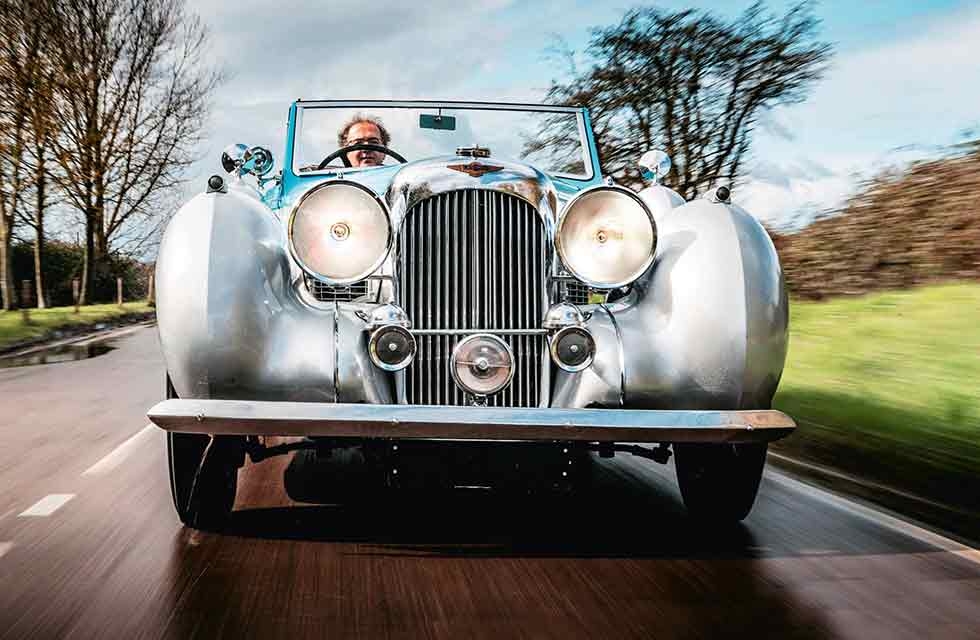
Ravishing 1937 Lagonda V12 Drophead Driven. Cast out by Rolls-Royce, WO Bentley took his technical genius to Staines and set out to build the best car in the world. This is it – the Lagonda V12. Words Russ Smith. Photography Alex Tapley.
Bentley’s Revenge
Driving the Lagonda V12 created by WO Bentley after he was fired from his eponymous company
The beauty of this Lagonda’s rakish design speaks for itself – especially when you realise that it was designed in 1938 and not a decade later. The lines are so elegant that you don’t need to be told this is an expensive car; it tells you. But what really makes a Lagonda V12 special is what lies beneath the skin – the fruits of WO Bentley’s eight-point plan to create – with a small and select team – the best car in the world. Cost no object. With the drive of a man still stinging from his treatment by Rolls-Royce after it took over the company that bore his name, Bentley’s team took it from a mission statement and a blank sheet of paper to Lagonda’s stand at the 1936 Olympia Motor Show in only 15 months. This feat was nothing short of a miracle, even if some of the engine parts on the show car had to be hurriedly carved in the carpentry shop.
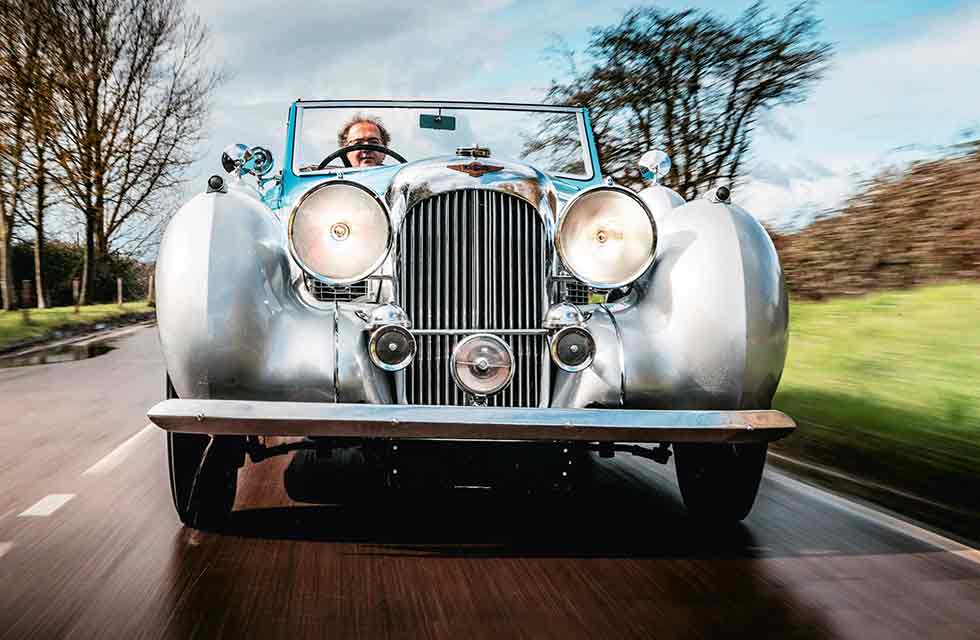
These V12s were priced accordingly, for those who could afford the very best, which meant just 190 were built between 1938 and 1940, and only around 53 of those were drophead coupés on the shortest of the three chassis lengths offered. It is one of those dropheads – back in the UK for the first time since 1987 – that we’ve jumped at the chance to drive today. Our intention is to find out just how advanced something can be from an era that was happy with Austin Tens, rudimentary suspension and minimal brakes.
The suicide door swings wide to allow entry in a dignified, stylish manner. It’s fitting. This is a machine that ticks all the presentation boxes. As with all self-respecting luxury cars of the era that kicks off with an imposing pair of giant Lucas headlamps, complemented here by a single ‘cyclops’ spotlamp flanked by two large and elaborate chrome-plated horns.
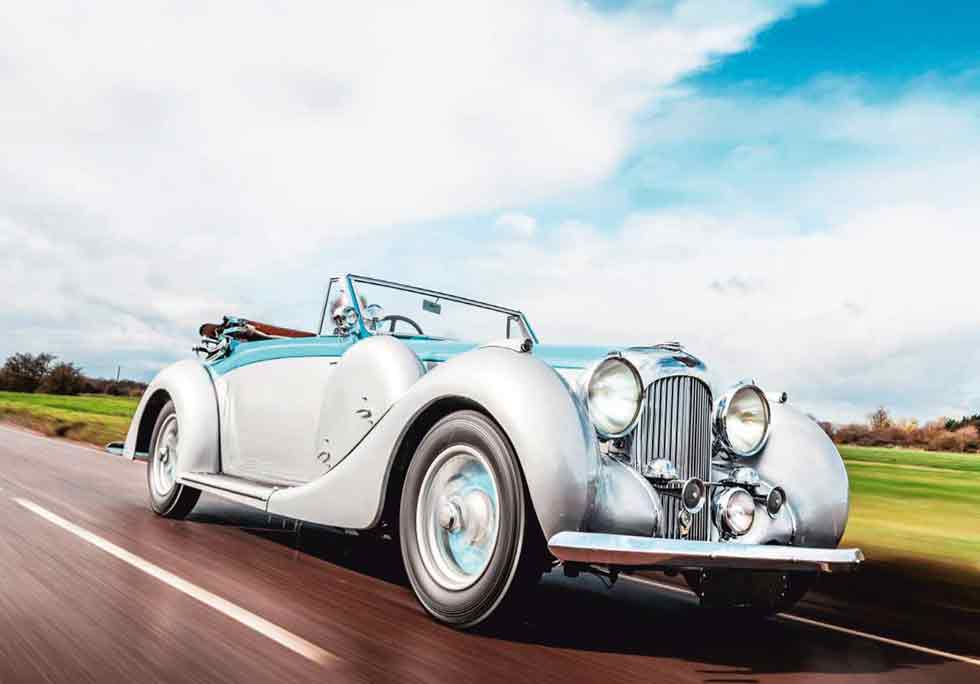
The view from the cabin is no less imposing, the substantial bonnet thrusting between the rolling landscape of wings and wheel covers. The nacelled sidelights that sit on top of the wings are great for guiding the car by, but the offside mirror proves largely useless for seeing anything with. I find a handy substitute in the chrome-domed rear of the hand-turnable spotlamp mounted to the screen pillar. It inadvertently provides a clear wide-angle view of all behind and to the side.
‘The gear lever is topped by what looks like a giant round humbug’
Starting requires no fiddling with choke controls or pumping of throttle, I’m told. Just move the hand-throttle control on the steering boss up a bit to keep the idle high while it warms up, turn the key and press the right one of several unmarked red buttons on the dashboard. I guess this is one of those, ‘If one has to ask…’ things. Without drama the V12 simply comes to life and purrs, though it’s more the purr of a cheetah than a domestic tabby. Time to escape this industrial corner of Essex head for some of the open countryside that is in abundance as soon as you head north from pretty much anywhere along the A13 corridor.
As you might expect, even for an ancient design of V12, it’s a smooth engine, whirring like a giant generator as you accelerate. It is remarkably flexible too, pulling strongly in any gear once you are rolling, so I tend to just use the higher ones unless an extra burst of power is needed. That’s where this engine really stands out from its contemporaries and excels as a cutting-edge piece of design – it loves to rev. It is easiest to compare the V12 to its six-cylinder stablemate, offered in the same or similar bodies and also classed as a 4.5-litre though it has 27cc fewer. That produces its 140bhp at 4000rpm, which in itself wasn’t bad for its day. But the V12 spins happily on to make a racy 175bhp at 5500rpm. Those are the bragging rights buyers were paying the big premium for.
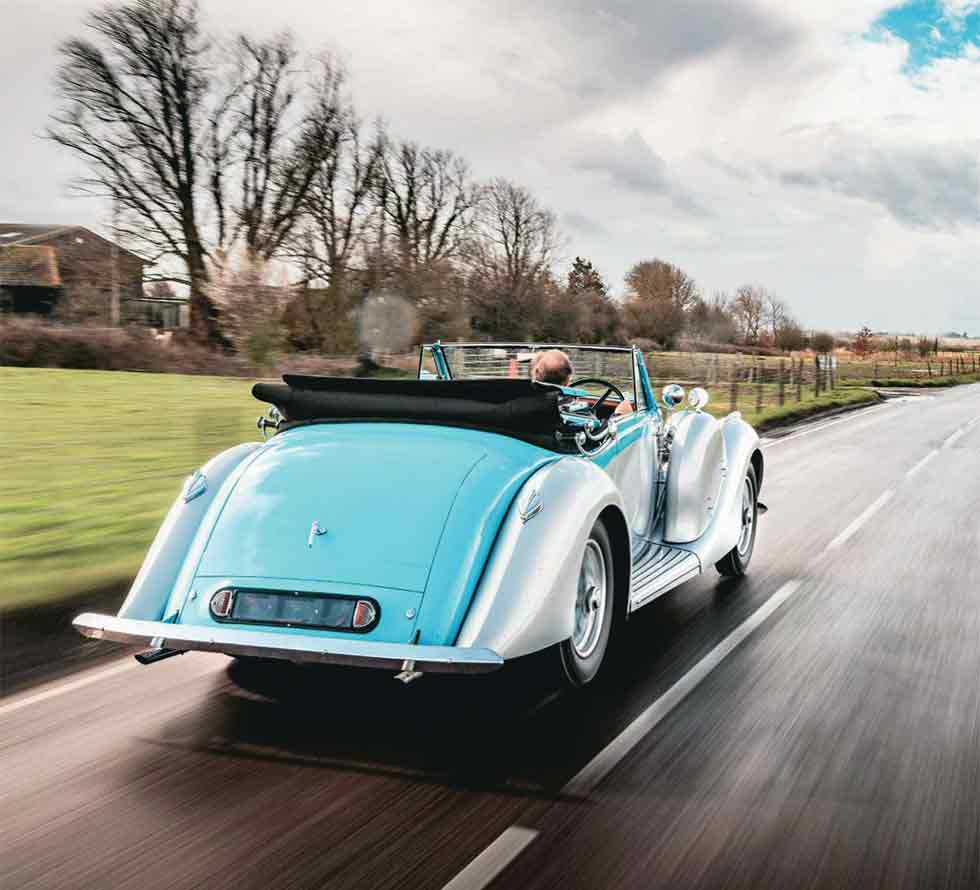
The seats are comfortable, if a little roly-poly, and there’s nothing in the way of side support, though that was rarely a consideration in the Thirties anyway, and certainly not in cars for rich folk to waft around in. In a way it is like a period Bentley, though even smoother and you sit much lower in the car.
The gear lever is oddly sprung to the left-and-back-for-reverse plane. I need to hold it lightly against that pressure to find first. That aside, it works like a regular four-speed, but always having to lean against that spring pressure. Learn that and there’s a lovely slick mechanical feel to the shift, the long lever topped by what looks like a giant round humbug with swirls of brown and cream. It’s almost good enough to lick.
‘The technique is to start turning before a corner to take up the slack in the steering’
There’s a significant amount of play at the rim of what is a suitably enormous four-spoke steering wheel. It’s something Motor Sport remarked on in its period road test, though the writer didn’t seem unduly concerned. After a few miles to get used to it, neither am I. Though it provides a bit of a shoulder workout, the feel and weight of the steering is actually very good, so the quickly adopted technique is to start turning before a corner to take up the slack. It isn’t much heavier at parking speeds either, but doesn’t have a great turning circle. Think five-point turn where three would normally do. The weighting is no doubt helped by it still running on correct period Dunlop crossply tyres. I’d hate to try it on stickier radials, which always add to the effort required. Anticipation is also required for any braking activity. With vast 16-inch drums that fill all available space behind the 18-inch wire wheels, the Lagonda actually stops very well for a car of its period. However, good in pre-war terms is a world away from even a Seventies classic, and there’s two tonnes of metal to bring to a halt here. But think ahead and push the pedal hard enough and they are reasonably effective in relative terms and couldn’t be made to fade on a cold March day.
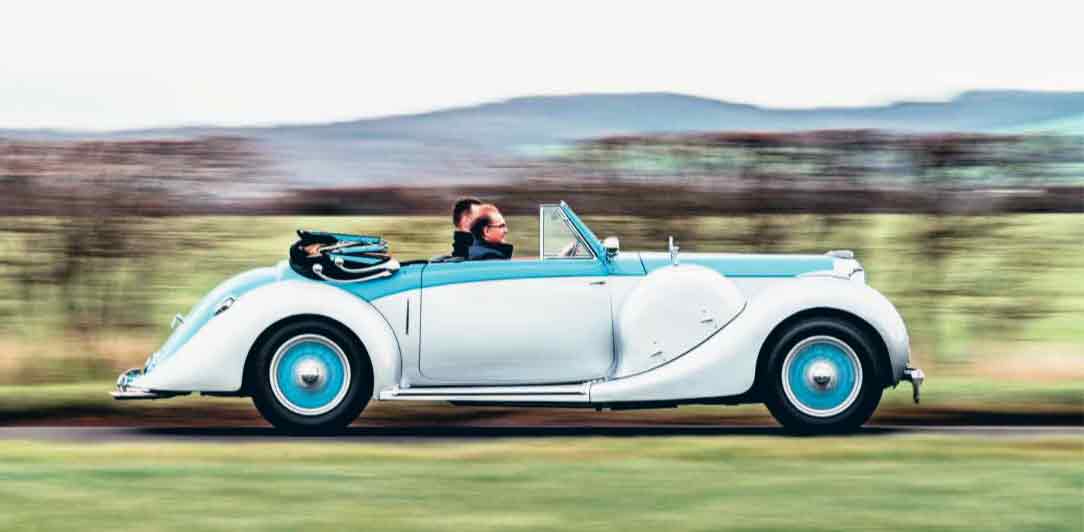
With clouds threatening to deluge, the hood proves easy enough to raise and latch – for two of us anyway. It isn’t light, but it is as well designed as the rest of the car, and doesn’t spoil the flow of the exterior lines at all. From the inside, the chrome and polished wood frame of the hood is a glorious collision of art and engineering.
If any area of this car’s design reveals its hurried execution it’s the dashboard layout. The ignition switch and starter are housed with several other controls in a cluster above the passenger’s right knee. Other unmarked buttons and warning lights are dotted randomly across the richly-grained wooden dash, past the rev counter and speedo to a four-in-one dial on the right tracking amps, fuel, oil pressure and water temp. It looks like some kind of Edwardian lab instrument, which only enhances the car’s quality feel. A further reminder of the different times this Lagonda inhabited is found in the clever little round ashtrays that pull out forward from the rear seat armrests; chromed of course.
The rest of the cabin is filled with lovely details, from a rather Wallace and Gromit crank to wind the windscreen open, to the lovely little Phinney-Walker eight-day clock set into the glovebox lid that looks like a gent’s pocket watch. Other delights include the long, leather-covered rope door pulls, and chrome thumb levers on the steering boss that allow you to vary the shock absorber settings – it’s labelled that and not the more technically correct ‘dampers’ – from Soft to Hard. I choose not to play with that because whatever it’s currently set to feels fine to the seat of my pants.
If I sound impressed then I’m getting the message across. Yet this largely unsung British great could so easily have never existed. Along with many motor manufacturers in the Thirties, in 1935 the receivers were called into Lagonda, a situation that was largely blamed on a short-term collapse in the sports car market after the introduction of the 30mph speed limit in towns.
‘The Lagonda’s styling paved the way for how cars for the truly affluent would look right into the mid-Fifties’
Then came the miracle of a Lagonda M45 Rapide winning the 1935 Le Mans 24-Hours, which persuaded solicitor Alan Good to put up £250,000 to buy the company, and most importantly WO Bentley to join it as Technical Director. The company’s factory in Staines was brought back to life and WO delivered his grand plan mentioned in the opening paragraph.
Bentley created the V12 engine that was to be the heart of the project from scratch, with the aid of most of Rolls-Royce’s racing department (yes, they had one back then), who had followed him to Lagonda. It was no lightweight, with cylinder heads and upper crankcase cast in iron. Alloy was only used for the lower crankcase. But it was a very advanced design, with a short stroke for its day that allowed the free revving mentioned earlier, and a chain-driven overhead camshaft for each bank of cylinders. The engine even gained some serious Le Mans pedigree when two special-bodied Lagonda V12s were entered for the 24 Hour race in 1939 and finished third and fourth overall.
In October 1937 the Lagonda V12 range was advertised in The Motor in a choice of three chassis lengths and five body styles, though as was the way back then quite a number were also given bespoke coachwork. Prices started at £1500, pitting them head-to-head with 4¼ Litre Bentleys, though those only had six-cylinder ohv engines – a lot less to shout about.

The Lagonda V12 found a niche as the preferred choice of the ‘sunglasses and mink coat brigade’, most notably British actor Ralph Richardson who, in April 1939, bought a drophead coupé that survives to this day. But Lagonda always struggled and just 190 or thereabouts of the V12 model were sold before war broke out. After that the company was in trouble again and quickly snapped up by David Brown to incorporate into Aston Martin.
Our well-travelled drophead, chassis 14062, was first registered in February 1939 to James Scott and Sons of Dundee, a successful jute mill owner and trader. At that time it was painted a rather more subdued single shade of gunmetal grey. Scott had little time to enjoy it, and the car was soon in the hands of R Abbot & Co in Acton, London. It was then laid up over the war and bought in June 1947 by the Earl of Wilton, also London-based. At that point service records show it still only had 2684 miles on the clock.
Two years later the V12 passed to Lady Alexandra Beasley of Wold House, near Malton in Yorkshire – now the site of a housing estate. The trail then goes cold until 1957 when it came into the hands of Lagonda Club member K Backhouse. In 1964 it crossed the Atlantic and went through the hands of several different owners in Illinois and Colorado for the next few decades.
One of those keepers during its American sojourn – probably during the Seventies though there’s no record in the history file – must have found the colour scheme a little dull. After another transatlantic crossing in 1987 a sales invoice from Porters in Kensington, shows it as beige and cream. London was only a brief stop-off for the Lagonda – that invoice records that it was bought for £19,000, plus another £2000 for ‘works carried out’ by Karl Ragnar Astrom in Umea, Sweden.
A 6000-hour restoration was completed in 2008, during which the Lagonda was treated to its current eye-popping blue over silver livery. It was barely used after that but is recorded as being sold by RM Sotheby’s at its May 2015 auction at Villa Erba in Italy, though the car remained in Sweden until recently, when it was sent over for Vintage & Prestige to sell on behalf of the owner.
And so here it is today. A day with the Lagonda V12 leaves nothing but admiration for how much was achieved so quickly by such a small but talented team. From behind the wheel it is instantly familiar and easy to drive. Without the unfortunate timing of war, the car may have been even more influential, but the world was a very different place after 1945. However, much of its styling did pave the way for how cars for the truly affluent would look right into the mid-Fifties – just look at any Alvis from the period. And that’s a decent legacy.
In its day this was the perfect car for the successful pre-war industrialist who found Rolls-Royce’s take on Bentleys a trifle dull and unimaginative.
Behind the wheel of a Lagonda V12, he would not have been disappointed.
Thanks to: Vintage & Prestige Classic Cars (vandp.net) – where this Lagonda V12 is currently for sale – and Orsett Hall.
TECHNICAL DATA FILE SPECIFICATIONS 1939 Lagonda V12 Drophead
Engine 4480cc cast-iron V12, sohc per bank, two SU downdraft carburettors
Power and torque 175bhp @ 6000rpm
Max Torque 340lb ft @ 4200rpm
Transmission Four-speed manual, rear-wheel drive
Suspension
Front: independent by double wishbones, longitudinal torsion bars and adjustable Armstrong lever-arm dampers
Rear: solid axle, semi-elliptic leaf springs, adjustable Armstrong lever-arm dampers and anti-roll bar
Steering Rack and pinion
Brakes Lockheed 16in drums all round
Weight 2007kg (4424lb)
Performance
Top speed: 104mph
0-60mph: 12.9sec
Fuel consumption 14mpg
Cost new £1605
Asking price £420,000
The cabin abounds in the kind of quirky detailing more common to brass-era cars – but the Lagonda was forward-thinking where it mattered. The 4.5-litre V12 employs two downdraught SU carburettors WO Bentley favoured tourqey engines – and this V12 was his retort to Rolls-Royce. Styling is by Frank Feeley, who later drew the Aston-Martin DB2. The hood mechanism is effective but best operated by two Rear seat passengers have their own armrests and ashtrays. Initially painting in a monotone gunmetal grey, the Lagonda has more recently worn two-tone paint schemes – first beige and cream, now blue over silver. No clues as to switch functions for the novice driver. Steering boss-mounted lever allows you to tweak damper settings on the fly.






